Canvas tents – the rugged, nostalgic cousin of your standard nylon dome. But when those storm clouds roll in, the question that can torment every camper’s mind is, are canvas tents waterproof? Don’t leave this up to chance.
The answer is both simple and complex, much like other camping situations. Most high-quality canvas tents offer some level of water protection. But when it comes down to brass tacks and serious storms, you may need to have a deeper understanding of what waterproof really means and how to achieve it.
In this article, we’ll dive into what makes canvas tents waterproof or not. And what you need to do to keep the rain out and the adventure going.
We link to products and services we think are useful for our readers. We may earn a commission for purchases made through some of these links. There’s no extra cost for you and it helps support our work. We really appreciate your support!

The Quick Rundown: Waterproof Canvas Tents
Canvas tents, while known for their durability and breathability, off some waterproof protection right out of the box. Some brands also go to more extreme measures to enhance the natural water-wicking capabilities of canvas by adding special coatings to prevent water penetration.
However, with the right tools and treatment, most high-quality canvas tents can become an excellent shelter in wet weather.
Want to see some of our top canvas tent picks? Check out these articles:
- Heavy Duty Tents for Camping
- The 10 Best Canvas Wall Tents Money Can Buy
- The 11 Best Canvas Tents for Camping
Unlike synthetic tents, canvas is a thicker material that can resist light rain. But to fully protect against a downpour, a little extra care is needed. This may involve applying a waterproofing treatment, like a silicone or wax-based coating. It’s also important to keep up with basic maintenance to prevent leaks over time.
In many cases, it’s ideal to use a second layer over the roof for the ultimate water protection. Known as a rain fly or fly sheet, this additional coverage can be the ideal solution for challenging situations or long-term use of canvas tents in rainy weather.
If you know the right tips and tricks, canvas tents can handle everything from light showers to heavy downpours. You can leave them up for entire seasons with confidence that your things will stay dry, if you:
- Use the right material and coatings
- Double up with a rain fly when appropriate
- Complete regular maintenance
While canvas tents can be waterproof, there are some essential steps every camper must take to achieve it. If you know what to do, a well-made canvas tent can keep you dry and comfortable on any camping trip.
The Full Guide: Reality of Waterproof Canvas Tents
There are many factors that affect a canvas tent’s ability to handle rain, from the quality of the material to the treatments applied and even how it’s used over time. In this guide, we’ll break down everything you need to know to make sure your canvas tent stands up to the elements and keeps you dry.
Here’s our breakdown of waterproof canvas tents:
- High-Quality Material with Adequate Weight
- Weatherproofing Coatings
- Using a Rain Fly for Extra Protection
- Craftsmanship Details to Look For
- Canvas Tent Maintenance Tips for Longevity

Starting Point: Canvas Material and Weight
When it comes to canvas tents, the material quality is crucial for how well it stands up to water. Not all canvas is created equal, and understanding the differences can help you make an informed choice. The two main types of canvas you’ll encounter are duck canvas and hybrid cotton-synthetic blends.
Duck Canvas:
- Made from tightly woven cotton
- Heavier and more durable than standard canvas
- Naturally water-resistant, but needs treatment for full waterproofing
Hybrid Cotton-Synthetic Blends:
- Combines natural cotton with synthetic fibers for added strength
- Lighter than pure cotton canvas
- More resistant to mold and mildew, making it ideal for humid environments
In addition to material type, weight is another key factor. Canvas is often rated by its weight, measured in ounces per square yard. Heavier canvas (typically 10-12 oz) offers better water resistance and durability, but it’s also bulkier and harder to transport. Lighter canvas (7-8 oz) is more portable but may need extra care to stay waterproof.
Higher quality canvas tents can come in traditional canvas or hybrid canvas. But they’re always heavier fabric. The lighter choices are usually not going to be as good of tents. If you want a light tent, don’t get any canvas. Especially if you need it to be waterproof.
Here’s a quick overview of what you should look for when shopping for a waterproof canvas tent:
- Weight rating: Aim for 10 oz or more for better waterproofing.
- Weave tightness: The tighter the weave, the more water-resistant.
- Breathability: Thicker canvas breathes better, reducing condensation inside the tent.
Choosing the right material ensures your tent can handle the elements and provide long-lasting shelter, but it’s just the start. Other factors, like waterproof coatings and craftsmanship, are equally important.

Weatherproofing Coatings: Factory vs. DIY Solutions
Canvas tents are sturdy, but they need a little help to truly stand up to heavy rain. Enter waterproof coatings. Many of the top manufacturers apply a protective layer at the factory. Some are better than others. Some of our favorite brands use proprietary wax or silicone-based coatings that they have thoroughly tested to ensure it helps wick water from the fabric.
You can also use DIY waterproof coatings. This can help initial waterproofing if you get a tent that isn’t well coated from the factory. Or this can help the waterproofing over time as the coatings eventually wear out and require some care to maintain.
When your tent’s original coating starts to fade, it’s time to roll up your sleeves. DIY weatherproofing is not as daunting as it sounds, and there are two popular methods: spray-on treatments and wax-based coatings.
- Silicone Sprays: Quick, simple, and good for spot-treating areas where water might seep in.
- Wax Coatings: A bit more labor-intensive but provides thicker protection, perfect for extending the life of your tent.
Whether you rely on the factory treatment or apply your own, understanding the options can keep you dry and extend your tent’s lifespan.
Waterproof coatings help a lot, but they aren’t magic. In a prolonged downpour, other steps may be needed. But with the right coating and care, your tent can weather many seasons. Just don’t overlook routine maintenance to keep it performing at its best.
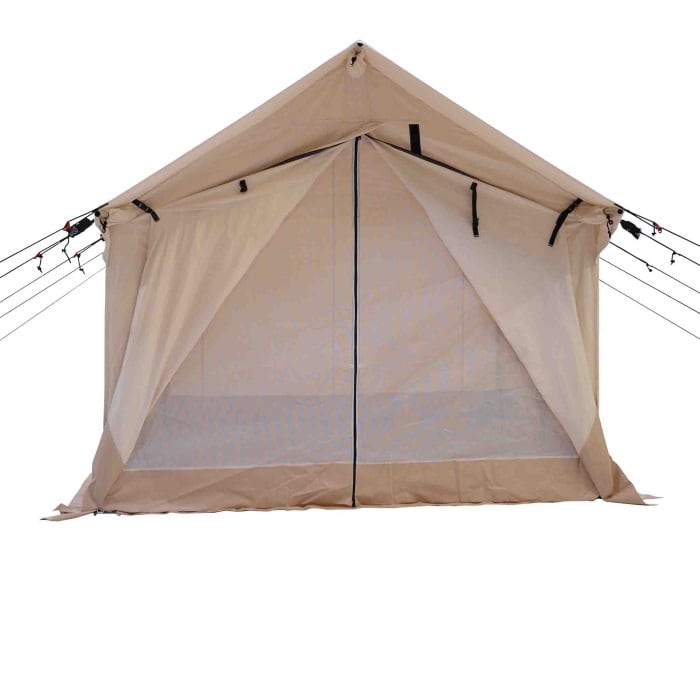
Rain Fly or Fly Sheet: Extra Protection in Heavy Downpours
Even the sturdiest canvas tent can struggle during a torrential downpour. While canvas provides excellent water resistance when properly treated, it’s not invincible. When faced with hours of heavy rain, many of the best canvas tents can spring a leak.
That’s where a rain fly or fly sheet comes in. We highly recommend using this extra layer in difficult conditions. It’s a secret weapon that can provide much better chances of staying dry.
This extra layer of protection creates a barrier between your tent and the elements, preventing water from seeping through and pooling on the tent’s surface.
Using a rain fly doesn’t just keep your tent dry; it also helps to manage condensation. Canvas tents are breathable, but moisture from inside the tent can still build up in rainy conditions. A rain fly directs water away from the tent, reducing the chance of internal dampness.
Why you should use a rain fly:
- Protection from heavy rain: Even waterproof canvas can benefit from a second layer in extended storms.
- Prevents pooling: A rain fly ensures water runs off quickly, avoiding weak spots.
- Condensation control: Helps keep the inside of your tent drier by managing internal moisture.
While canvas tents can handle most weather on their own, using a rain fly or fly sheet during extended downpours adds an extra layer of confidence. It can be the difference between a comfortable and dry camping experience or a wet and soggy trip.

Craftsmanship: Features to Look for in a Quality Canvas Tent
When it comes to canvas tents, the devil is in the details. High-quality craftsmanship can make a big difference in how well your tent performs under pressure, especially in bad weather. Beyond the material and waterproofing treatments, the construction of the tent itself is key to keeping water out.
One critical feature is the stitching. You want double stitched seams at minimum, which offers reinforced protection for the weakest points in a tent’s defense against water.
If you can find a canvas tent that uses taped or sealed seams, it’s a great layer of extra protection. These features are especially important in areas where rainwater tends to collect, such as the roof or corners.
Other elements to consider are the zippers and flaps. High-quality tents will have storm flaps over the zippers, preventing water from sneaking through these often-overlooked entry points. In addition, tents with ventilation systems are great for reducing internal condensation, which can become a problem during rainy weather.
Features to look for:
- Double stitching: Reinforces seams to prevent leaks.
- Sealed seams: Keeps water from seeping through weak points.
- Storm flaps: Protect zippers from water infiltration.
- Ventilation systems: Helps manage moisture and keeps air circulating.
These craftsmanship details may seem minor, but they play a huge role in how well your tent holds up when the weather turns nasty. Paying attention to these features will ensure you’re investing in a tent built to withstand the elements, giving you peace of mind for your next adventure.
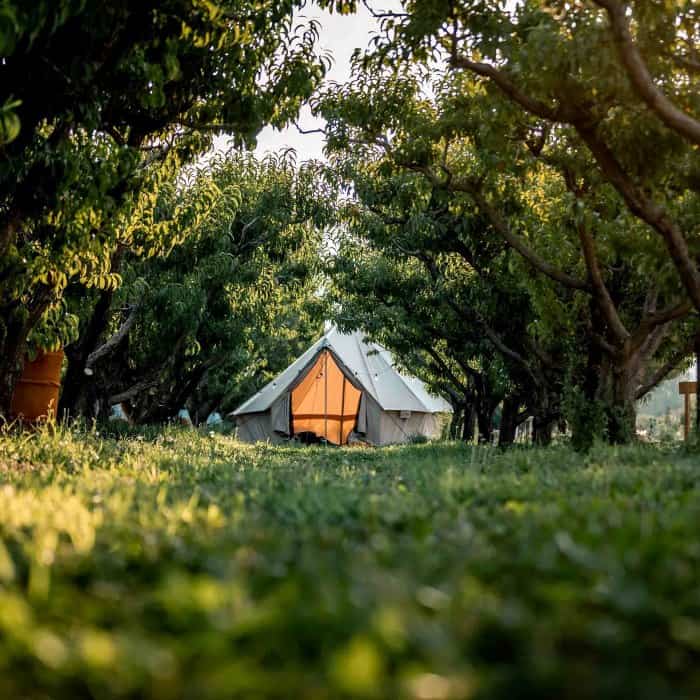
Canvas Tent Maintenance: Top Tips for Longevity
Maintaining a canvas tent properly is essential if you want it to last through many adventures. While canvas is durable, a little upkeep goes a long way in ensuring your tent stays waterproof, mold-free, and ready for any conditions.
Here are our top tips for maintaining a canvas tent and making sure it stays waterproof:
- Clean Often: Dirt, debris, and moisture can damage the fabric over time. After each trip, shake out any dirt and gently scrub the canvas with a soft brush and mild soap. Never use harsh chemicals, as they can strip waterproof coatings.
- Dry Completely: This is one of the most important steps. Packing away a damp tent is a recipe for mold and mildew. Always let your tent air out and dry fully before storing it.
- Reapply Waterproofing: Over time, the tent’s waterproof coating can wear off, especially after exposure to heavy rain. Reapply a waterproofing treatment every few seasons or as needed to ensure your tent remains watertight. Check with your manufacturer to follow their recommendations.
- Store in a Cool, Dry Place: Proper storage extends the life of your tent. Avoid storing it in damp or hot areas like basements or garages. Instead, keep it in a breathable storage bag in a cool, dry place.
These tips will help to protect your canvas tent from wear and tear, ensuring it provides shelter and comfort for years to come.
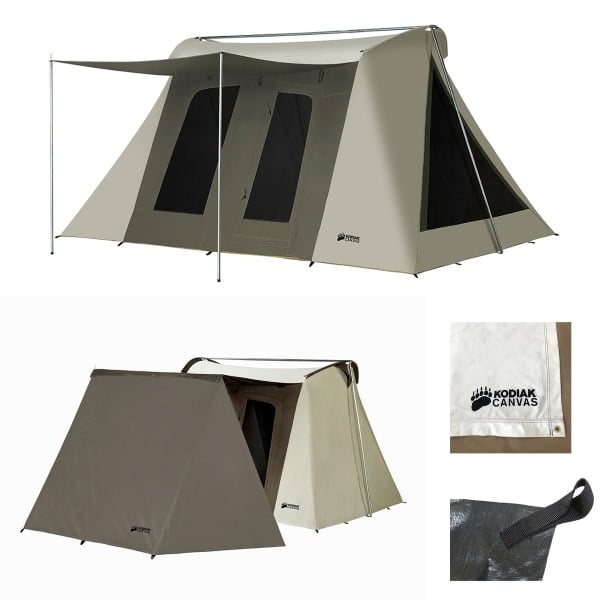
Top Canvas Tent Choices: White Duck, Kodiak, and TETON Sports
Now that we’ve covered the essentials of canvas tents, let’s dive into the top brands that offer the best options for your next adventure. While canvas tents require some care and attention, choosing a well-made product from a reputable brand can make all the difference.
Below are three standout options, ranging from premium to budget-friendly, with something for every camper.

1. White Duck: The Premium Choice
When it comes to canvas tents, White Duck is the gold standard. Known for its high-quality materials and exceptional craftsmanship, White Duck tents use high-quality canvas that’s treated with a proprietary DYNADUCK treatment, making them not only waterproof but also resistant to UV rays and mildew.
The heavy-duty double-stitched seams, reinforced corners, and premium YKK zippers ensure durability in all conditions.
We are obsessed with White Duck canvas tents and highly recommend them if you want to get a canvas tent worth investing in. Your search can start and stop right here. They also include everything you need, from included frames to fly sheets. You can get an incredible waterproof tent in minutes.
- Best for: Long-term camping, all-weather durability
- Standout feature: Heavyweight canvas (10.10 oz) and industry-leading water repellency
- Recommended tent: White Duck Regatta Bell Tent – perfect for family or luxury camping with ample space and ventilation

|
WhiteDuck Alpha Pro Wall Tent |
Buy Now Read Details |

2. Kodiak: A Reliable Alternative
Kodiak tents are another excellent option, offering a balance of quality and price. This brand focuses a little more on smaller tents but also has large options. Every one is made from durable, waterproof cotton canvas.
Kodiak’s Cabin Tents are especially popular for their rugged performance and expansive headroom with a limited footprint. These tents come with reinforced seams and Hydra-Shield coating, providing solid weather resistance, though they may need reapplication over time.
- Best for: Casual campers and weekend trips
- Standout feature: Smaller cabin tents that are easy to set up but still rugged
- Recommended tent: Kodiak Canvas Flex-Bow Tent – great for smaller groups looking for durability without the bulk

|
Kodiak Flex-Bow Canvas Tent Deluxe |
Buy Now More Details |
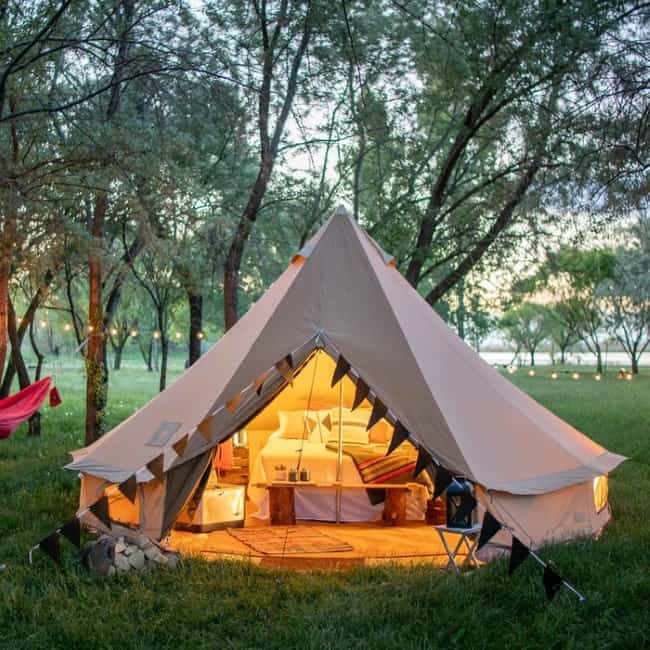
3. TETON Sports: The Budget-Friendly Option
If you’re looking for a more affordable canvas tent, TETON Sports offers reliable options without breaking the bank. While not as heavy-duty as White Duck or Kodiak, TETON Sports tents are still solid performers in moderate conditions.
They use slightly less expensive materials to keep costs down. While they may not offer the same level of quality, they’re perfect for the occasional camper. Once again, a rain fly is highly recommended to ensure waterproof capabilities.
- Best for: Budget-conscious campers or those new to canvas tents
- Standout feature: Lightweight design, easy to transport
- Recommended tent: TETON Sports Sierra Canvas Tent – a great entry-level option with decent waterproofing for a fraction of the price
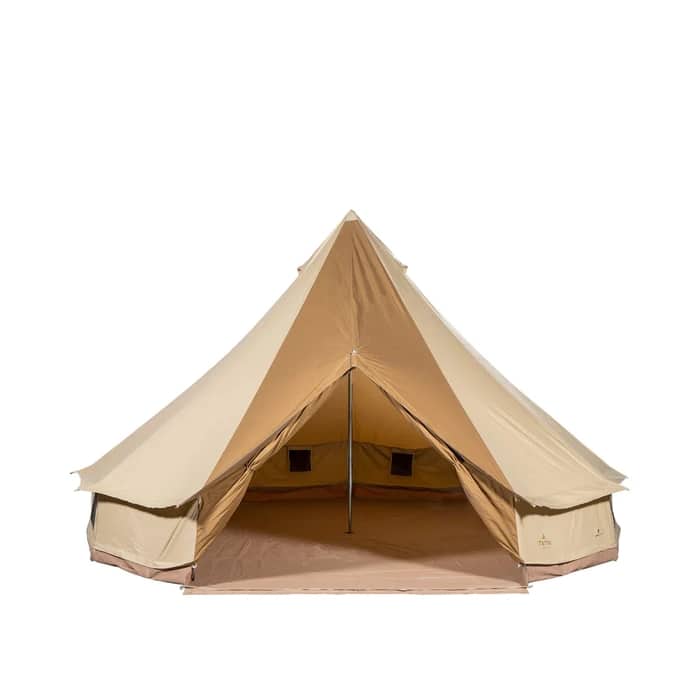
|
Teton Sports Sierra Canvas Tent |
Buy Now More Details |
Wrap Up: Waterproof Canvas Tents
Canvas tents offer durability, breathability, and long-lasting performance, but they require the right care to stay waterproof and functional. From choosing high-quality material like White Duck’s premium canvas to applying and maintaining waterproof coatings, you can ensure your tent will handle any adventure.
Remember to clean, dry, and store your tent properly after each trip, and reapply waterproofing treatments when needed.
Ready to invest in a reliable, weatherproof tent? Check out the White Duck canvas tents for top-tier quality. Or head over to our Heavy Duty Tents for Camping article to find your favorite match.

